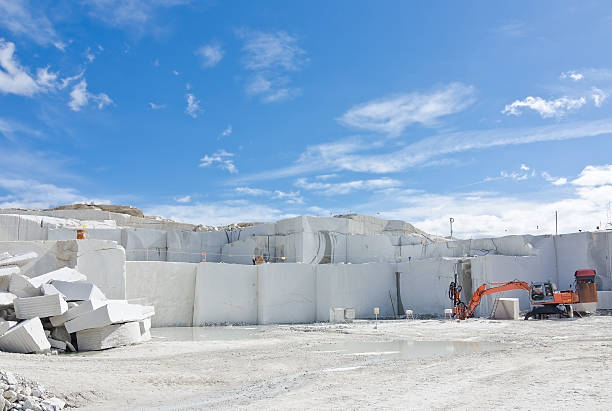Exploring Granite Quarries in South Africa: A Comprehensive Overview
Exploring Granite Quarries in South Africa: A Comprehensive Overview
Blog Article
Discovering the Rich Background and Lasting Practices of Granite Quarrying
As we stand on the precipice of uncovering the detailed tapestry of granite quarrying, a trip through time reveals not just the physical act of drawing out stone but likewise the cultural and historic relevance woven right into the very material of this practice. From the ancient beginnings that laid the structure for modern-day quarrying strategies to the lasting techniques that are shaping the future of this industry, each carve mark on granite surface areas tells a tale waiting to be uncovered (granite quarries in south africa). The tradition of granite quarrying extends much past mere extraction; it is a testament to human ingenuity, durability, and the long-lasting appeal of this marvelous rock
Ancient Beginnings of Granite Quarrying
Going back to old civilizations, the method of quarrying granite has actually been an essential part of human background and building innovation. The earliest evidence of granite quarrying go back to old Egypt, where substantial pyramids and elaborate sculptures were crafted from this durable stone. The Egyptians used primitive devices to extract granite blocks from quarries, showcasing the relevance of this product in their huge building and constructions.
Moving onward in background, the Greeks likewise made substantial payments to the quarrying of granite. The Greeks used granite in numerous building marvels, such as holy places and sculptures, demonstrating their ability in shaping and sculpting this sturdy stone. The Romans better improved the strategies of quarrying granite, utilizing innovative devices like blades and hammers to essence and form granite for their iconic frameworks.
Via the centuries, the practice of quarrying granite has actually advanced, with modern-day innovations enhancing effectiveness while keeping the timeless appeal of this natural stone - granite quarries in south africa. From old people to modern building contractors, the heritage of granite quarrying proceeds to form our globe
Advancement of Quarrying Methods
The advancement of quarrying strategies has been marked by a continuous progression towards greater performance and precision in removing granite. Early quarrying techniques involved hands-on labor with basic tools such as knives, hammers, and wedges to draw out granite blocks from the earth.
In more current times, the introduction of machinery changed the quarrying industry, making it possible for quicker extraction prices and enhanced efficiency. Technologies such as ruby cable saws, high-pressure water jets, and pneumatically-driven drills have come to be conventional in modern-day quarries, permitting for accurate cutting and lowered waste. Developments in computer-controlled tools and 3D modeling have maximized quarrying procedures, leading to very little environmental influence and enhanced sustainability practices. As the demand for granite remains to climb, the development of quarrying techniques remains integral to meeting market requires effectively and sustainably.
Cultural Value of Granite
Granite holds an extensive social importance across different people as a result of its enduring visibility in building work of arts and admired monuments. From the marvelous pyramids of Egypt to the intricate makings of the Angkor Wat holy place in Cambodia, granite has been a product of choice for revealing majesty and longevity in cultural heritage. In old Rome, granite columns adorned holy places and public structures, signifying strength and durability. The cultural importance of granite expands past its physical attributes; it personifies resilience, stability, and eternity, making it an icon of enduring legacies and customs.

Sustainable Practices in Quarrying
In the middle of the abundant background of granite quarrying and its cultural significance lies a growing emphasis on sustainable practices within the sector. As environmental recognition and problems about source deficiency have increased around the world, the quarrying sector has significantly embraced sustainable methods to decrease its effect on the setting and bordering communities.

In addition, recovery and rehabilitation of quarry sites post-extraction are important to lasting techniques. By restoring quarried areas to a natural or valuable state, such as producing wildlife environments or recreational spaces, quarriers can balance out the ecological impact of their operations and add positively to the neighborhood ecosystem.
Legacy of Granite Quarrying
With a historic background soaked in craftsmanship and commercial development, what enduring influence has granite quarrying left on the landscape of modern culture? The heritage of granite quarrying goes beyond plain removal techniques; it has actually shaped architectural marvels, city landscapes, and social heritage worldwide. The sturdy nature of granite has made it a recommended choice for monuments, structures, and framework, standing as a testimony to the ability and virtuosity of quarry employees throughout generations.
Furthermore, the economic footprint of granite quarrying can not be neglected. The industry remains to supply job opportunity and drive local economic situations in regions where granite removal prevails. It has actually likewise spurred technical developments in quarrying strategies and equipment, bring about extra effective and sustainable methods.
In regards to sustainability, the legacy of granite quarrying consists of efforts to alleviate ecological impacts via improvement tasks and accountable resource administration. By stabilizing financial interests with environmental stewardship, the market makes every effort to ensure that future generations can remain to gain from this enduring natural resource.
Verdict

Report this page